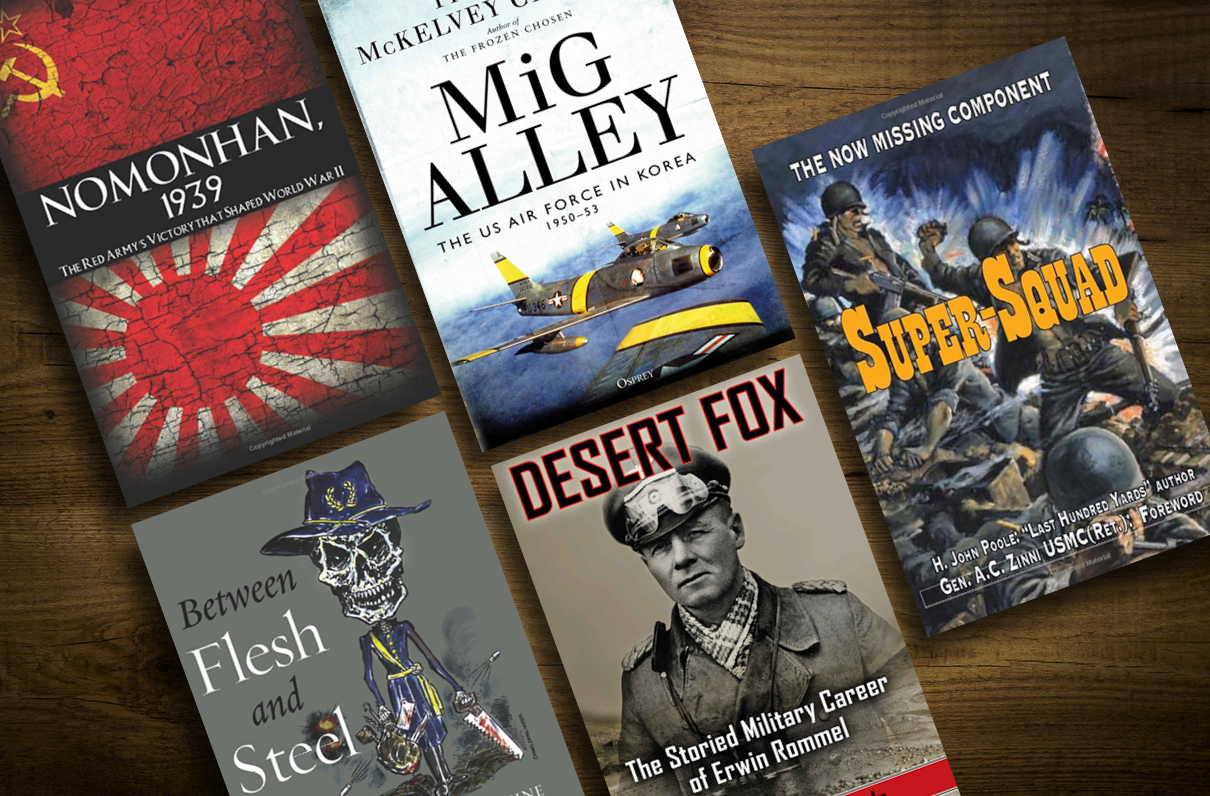By Col. William D. Bushnell, USMC (Ret)
From World War II and Korean War history to a look at military medicine throughout the centuries, here are the latest recommendations for MOAA’s Military Professional Reading List.
You can order the books through the links in the titles below; MOAA is an Amazon Associate and earns money from qualifying purchases, with the revenue supporting The MOAA Foundation.
Desert Fox: The Storied Military Career of Erwin Rommel
By Samuel W. Mitcham, Jr. Regnery History, 2019. ISBN 978-1-62157-721-8.
Until historian Mitcham came along, German Field Marshal Erwin Rommel’s premier biographer was Brigadier Desmond Young with his 1950 book, Rommel: The Desert Fox. Now, however, Mitcham’s biography of Rommel (1891-1944) eclipses Young’s by a refreshingly wide margin.
This Desert Fox is an outstanding military biography of one of Germany’s best generals in World War II. Mitcham’s research and vivid narrative tell of the man and his battlefield victories and defeats in North Africa, Italy, and France, as well as revealing his fatally contentious relationships with Hitler and other top Nazis who despised him for his candor, courage, tactical and strategic acumen, and stunning generalship.
This is exciting military history well told. See also Rommel’s own book Attacks (Athena Press, 1979) and B.H. Liddel Hart’s The Rommel Papers (DaCapo, 1982).
MiG Alley: The U.S. Air Force in Korea, 1950-1953
By Thomas McKelvey Cleaver. Osprey, 2019. ISBN 978-1-47283-608-3.
Cleaver is a Korean War aviation historian, and this history of the U.S. Air Force during the Korean War is a masterpiece of modern aviation history, well-researched, well-written, and refreshingly candid in its balanced appraisal of U.S. air power in aerial combat against the MiG-15.
He tells of the air operations of propeller-driven aircraft and jet fighters, and debunks the often accepted myths of American air superiority. He reveals that air combat usually meant air parity against the superior MiG-15, especially when flown by veteran Russian pilots. Cleaver also describes exciting aerial combat, dogfights, crashes, bail-outs, rescues, losses, and the USAF’s ever-evolving changes in tactics and technology. See also Cleaver’s Holding the Line (Osprey, 2019) about naval airpower in Korea.
Super-Squad: The Now Missing Component
By H. John Poole. Posterity Press, 2020. ISBN 978-0-9818659-6-6.
Coinciding with the Marine Corps’s latest plan to reorganize the Marine rifle squad, Poole’s latest book offers a strong counterpoint to the new plan, focusing instead on a rifle squad’s organic firepower and proven tactical flexibility rather than on reliance on electronic gizmos. Poole uses historical examples of successful infantry squad organization, weapons, and tactical employment, as well as modern examples of how potential adversaries today (China, Russia, North Korea, and others) organize and train to fight with their infantry squads.
He also presents excellent modern scenarios of squad combat in cities, jungles, mountains, and open terrain – common sense small unit tactics relying on people leadership, weapons, and training, not on computers or drones. A provocative and cautionary appraisal of the future of the Marine rifle squad.
Between Flesh and Steel: A History of Military Medicine From the Middle Ages to the War in Afghanistan
By Richard A. Gabriel. Potomac Books, 2013. ISBN 978-1-61234-420-1.
This is a fascinating yet gruesome history of military medicine in war, from the “squalid butchery” of the Middle Ages to the increased lethality of modern weapons. Gabriel is a prolific historian and talented writer, describing in vivid detail the medical theory and practice of the day, including the early barber-surgeons of the 17th century and Napoleon’s “flying ambulances,” to Korea’s MASH units, and today’s remarkable treatment of trauma wounds and PTSD.
Graphic descriptions include treatment of battlefield wounds, burns, infections, hygiene, surgeries, psychiatric care, antiseptics, anesthesia, vaccinations, medical evacuations, plasma and blood transfusions, and the introduction of the soldier’s first aid kits.
Nomonhan 1939: The Red Army’s Victory That Shaped World War II
By Samuel D. Goldman. Naval Institute Press, 2012. ISBN 978-1-59114-329-1.
The Battle of Nomonhan in Manchuria in 1939, fought between the Russians and the Japanese was “the most important World War II battle that most people never heard of,” according to author Stuart Goldman. While the Germans were invading Poland, the Russian army crushed Japan’s vaunted Kwantung Army in Manchuria in a titanic battle that neither nation wanted or expected, but blundered into.
The Russian victory erased their humiliating defeat in the 1905 Russo-Japanese War and catapulted General Georgy Zhukov into World War II prominence. Massed artillery, armor, and human wave infantry attacks marked this four-month bloody battle.
Col. William D. Bushnell, USMC (Ret), is a regular contributor to MOAA.org and Military Officer magazine.
Stay Informed
It’s more important than ever to make sure you’re in the know and your military benefits are protected.
